Numeracy Assignment: Data Analysis and Application of Math Functions
VerifiedAdded on 2024/07/22
|17
|1976
|175
Homework Assignment
AI Summary
This numeracy assignment delves into various mathematical concepts and their practical applications. It begins with an exploration of the BODMAS rule, emphasizing its importance in solving mathematical problems, and includes real-life examples such as ratio analysis in investment decisions. The assignment further discusses the interrelation between fractions, decimals, and percentages, illustrating their use in comparative analysis. Statistical measures like mean, median, and mode are also examined, with examples demonstrating their application in data interpretation. The assignment includes calculations of percentage change, growth rates, and index numbers, along with data interpretation from pie charts and tables related to higher education statistics. The student also reflects on their learning process and data interpretation, and Desklib provides access to similar assignments and study tools to aid students.
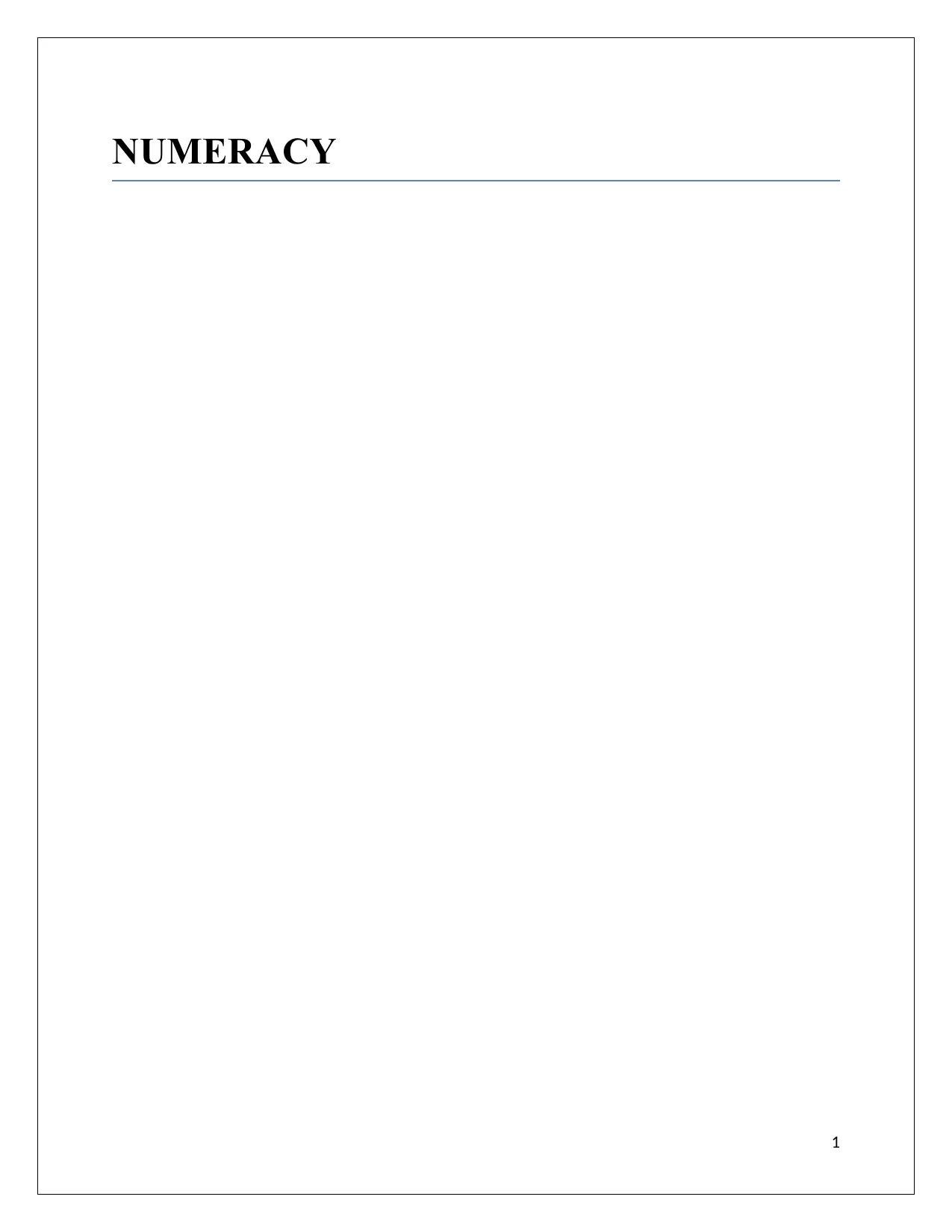
NUMERACY
1
1
Paraphrase This Document
Need a fresh take? Get an instant paraphrase of this document with our AI Paraphraser
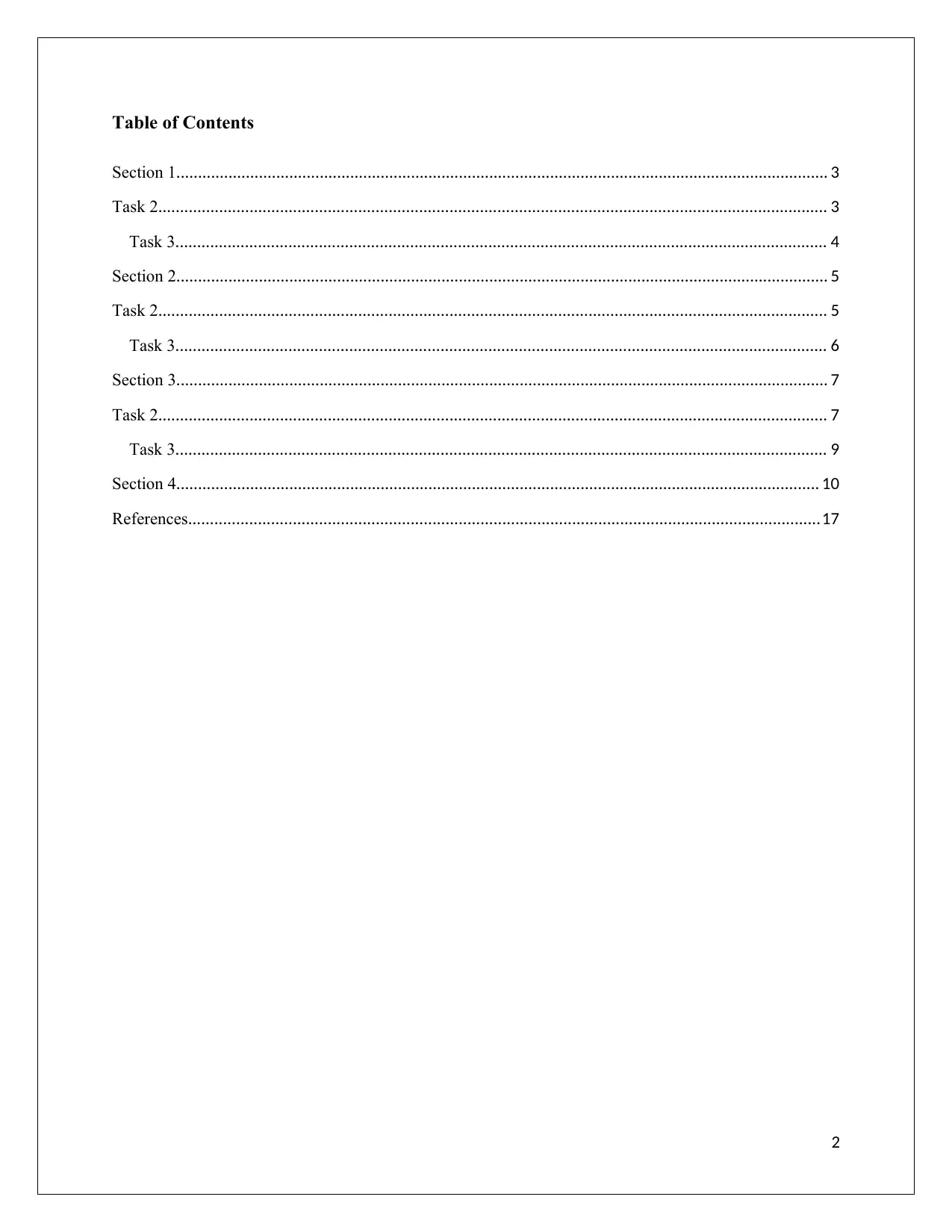
Table of Contents
Section 1...................................................................................................................................................... 3
Task 2.......................................................................................................................................................... 3
Task 3...................................................................................................................................................... 4
Section 2...................................................................................................................................................... 5
Task 2.......................................................................................................................................................... 5
Task 3...................................................................................................................................................... 6
Section 3...................................................................................................................................................... 7
Task 2.......................................................................................................................................................... 7
Task 3...................................................................................................................................................... 9
Section 4.................................................................................................................................................... 10
References.................................................................................................................................................17
2
Section 1...................................................................................................................................................... 3
Task 2.......................................................................................................................................................... 3
Task 3...................................................................................................................................................... 4
Section 2...................................................................................................................................................... 5
Task 2.......................................................................................................................................................... 5
Task 3...................................................................................................................................................... 6
Section 3...................................................................................................................................................... 7
Task 2.......................................................................................................................................................... 7
Task 3...................................................................................................................................................... 9
Section 4.................................................................................................................................................... 10
References.................................................................................................................................................17
2
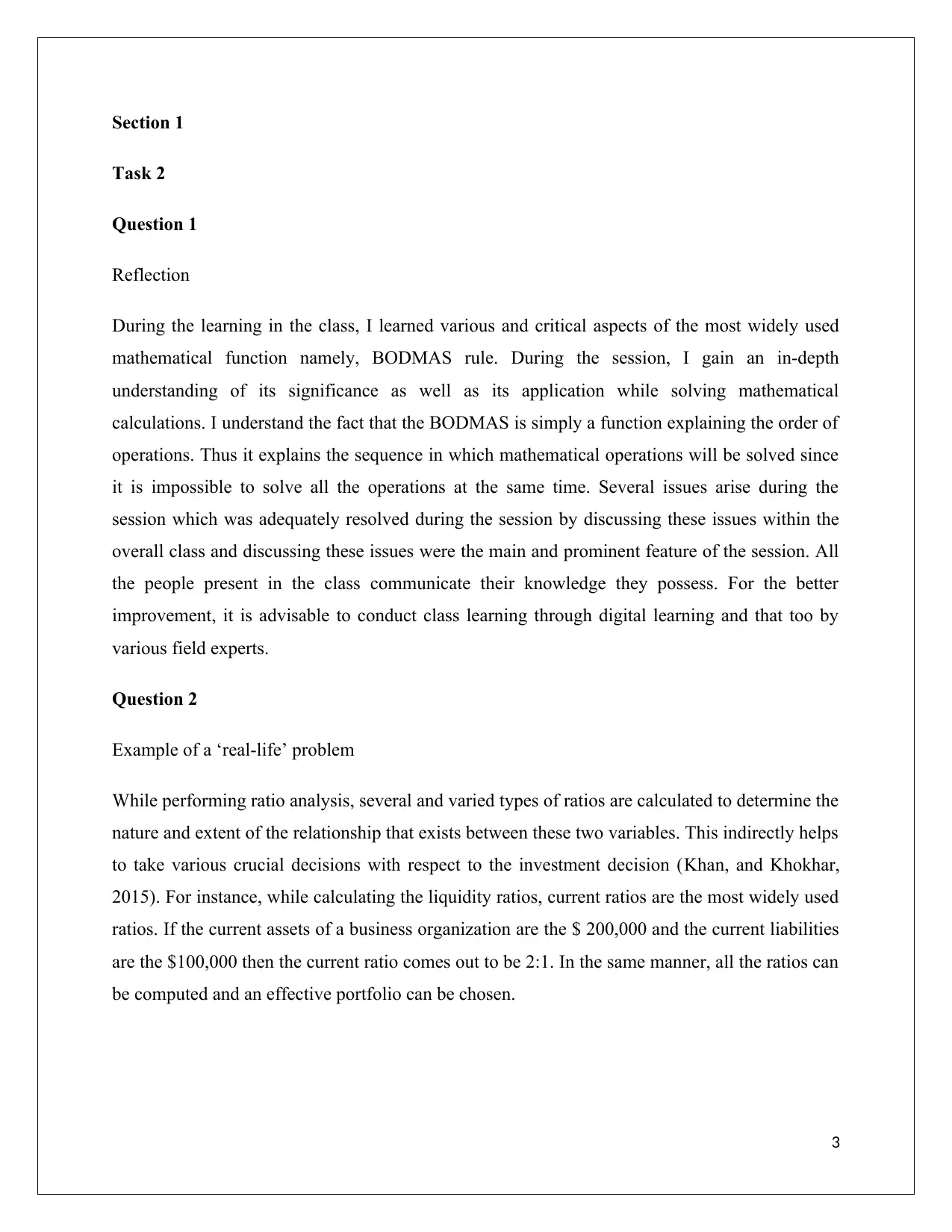
Section 1
Task 2
Question 1
Reflection
During the learning in the class, I learned various and critical aspects of the most widely used
mathematical function namely, BODMAS rule. During the session, I gain an in-depth
understanding of its significance as well as its application while solving mathematical
calculations. I understand the fact that the BODMAS is simply a function explaining the order of
operations. Thus it explains the sequence in which mathematical operations will be solved since
it is impossible to solve all the operations at the same time. Several issues arise during the
session which was adequately resolved during the session by discussing these issues within the
overall class and discussing these issues were the main and prominent feature of the session. All
the people present in the class communicate their knowledge they possess. For the better
improvement, it is advisable to conduct class learning through digital learning and that too by
various field experts.
Question 2
Example of a ‘real-life’ problem
While performing ratio analysis, several and varied types of ratios are calculated to determine the
nature and extent of the relationship that exists between these two variables. This indirectly helps
to take various crucial decisions with respect to the investment decision (Khan, and Khokhar,
2015). For instance, while calculating the liquidity ratios, current ratios are the most widely used
ratios. If the current assets of a business organization are the $ 200,000 and the current liabilities
are the $100,000 then the current ratio comes out to be 2:1. In the same manner, all the ratios can
be computed and an effective portfolio can be chosen.
3
Task 2
Question 1
Reflection
During the learning in the class, I learned various and critical aspects of the most widely used
mathematical function namely, BODMAS rule. During the session, I gain an in-depth
understanding of its significance as well as its application while solving mathematical
calculations. I understand the fact that the BODMAS is simply a function explaining the order of
operations. Thus it explains the sequence in which mathematical operations will be solved since
it is impossible to solve all the operations at the same time. Several issues arise during the
session which was adequately resolved during the session by discussing these issues within the
overall class and discussing these issues were the main and prominent feature of the session. All
the people present in the class communicate their knowledge they possess. For the better
improvement, it is advisable to conduct class learning through digital learning and that too by
various field experts.
Question 2
Example of a ‘real-life’ problem
While performing ratio analysis, several and varied types of ratios are calculated to determine the
nature and extent of the relationship that exists between these two variables. This indirectly helps
to take various crucial decisions with respect to the investment decision (Khan, and Khokhar,
2015). For instance, while calculating the liquidity ratios, current ratios are the most widely used
ratios. If the current assets of a business organization are the $ 200,000 and the current liabilities
are the $100,000 then the current ratio comes out to be 2:1. In the same manner, all the ratios can
be computed and an effective portfolio can be chosen.
3
⊘ This is a preview!⊘
Do you want full access?
Subscribe today to unlock all pages.

Trusted by 1+ million students worldwide
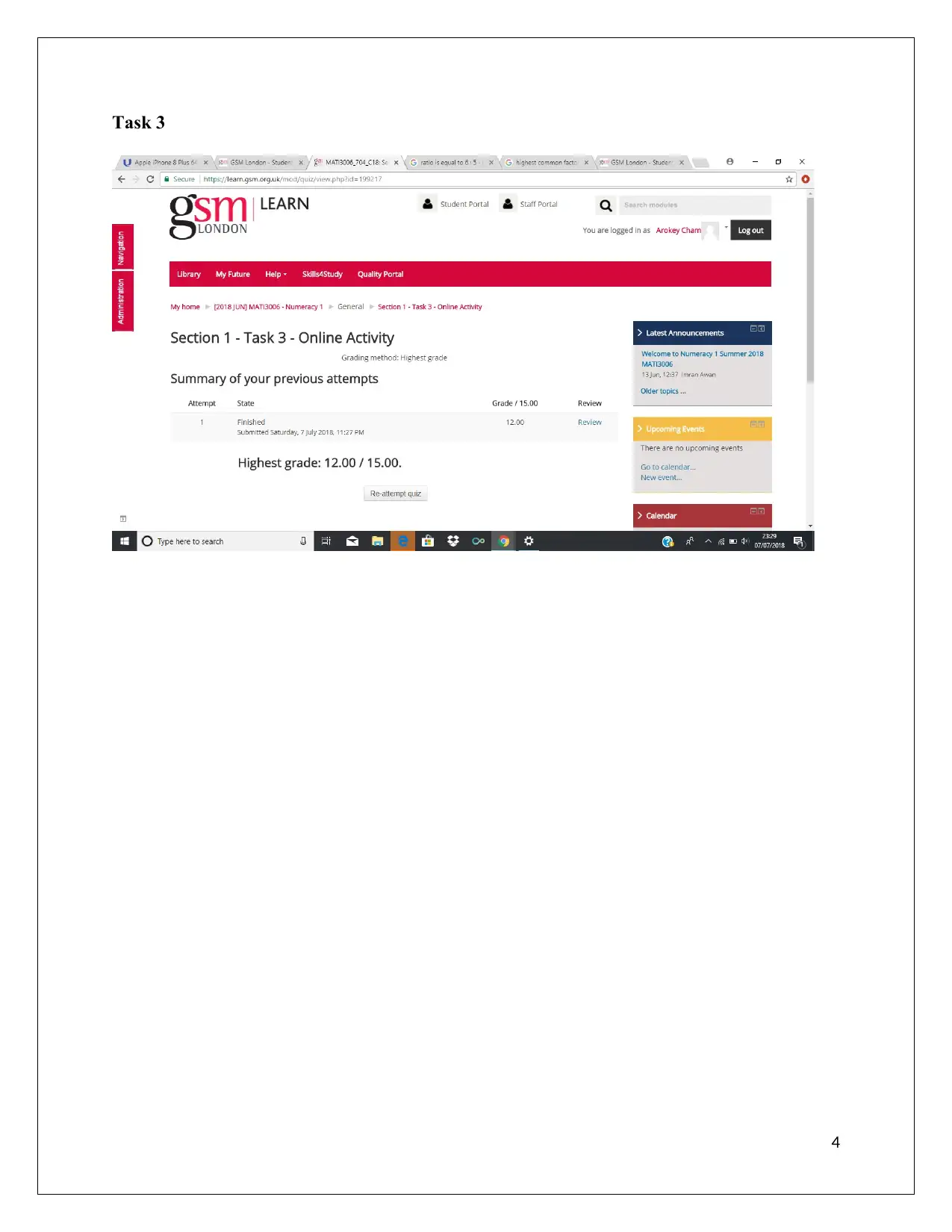
Task 3
4
4
Paraphrase This Document
Need a fresh take? Get an instant paraphrase of this document with our AI Paraphraser
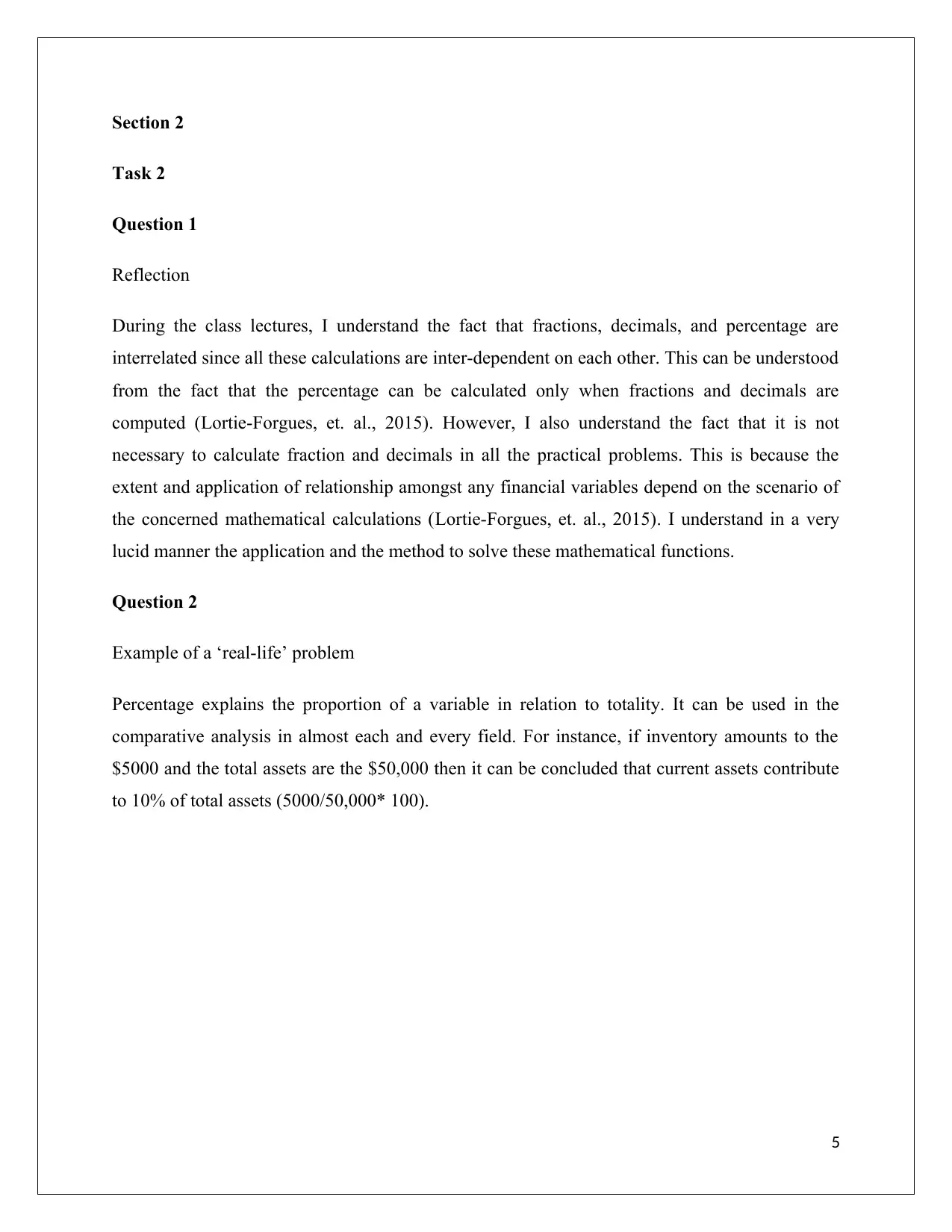
Section 2
Task 2
Question 1
Reflection
During the class lectures, I understand the fact that fractions, decimals, and percentage are
interrelated since all these calculations are inter-dependent on each other. This can be understood
from the fact that the percentage can be calculated only when fractions and decimals are
computed (Lortie-Forgues, et. al., 2015). However, I also understand the fact that it is not
necessary to calculate fraction and decimals in all the practical problems. This is because the
extent and application of relationship amongst any financial variables depend on the scenario of
the concerned mathematical calculations (Lortie-Forgues, et. al., 2015). I understand in a very
lucid manner the application and the method to solve these mathematical functions.
Question 2
Example of a ‘real-life’ problem
Percentage explains the proportion of a variable in relation to totality. It can be used in the
comparative analysis in almost each and every field. For instance, if inventory amounts to the
$5000 and the total assets are the $50,000 then it can be concluded that current assets contribute
to 10% of total assets (5000/50,000* 100).
5
Task 2
Question 1
Reflection
During the class lectures, I understand the fact that fractions, decimals, and percentage are
interrelated since all these calculations are inter-dependent on each other. This can be understood
from the fact that the percentage can be calculated only when fractions and decimals are
computed (Lortie-Forgues, et. al., 2015). However, I also understand the fact that it is not
necessary to calculate fraction and decimals in all the practical problems. This is because the
extent and application of relationship amongst any financial variables depend on the scenario of
the concerned mathematical calculations (Lortie-Forgues, et. al., 2015). I understand in a very
lucid manner the application and the method to solve these mathematical functions.
Question 2
Example of a ‘real-life’ problem
Percentage explains the proportion of a variable in relation to totality. It can be used in the
comparative analysis in almost each and every field. For instance, if inventory amounts to the
$5000 and the total assets are the $50,000 then it can be concluded that current assets contribute
to 10% of total assets (5000/50,000* 100).
5
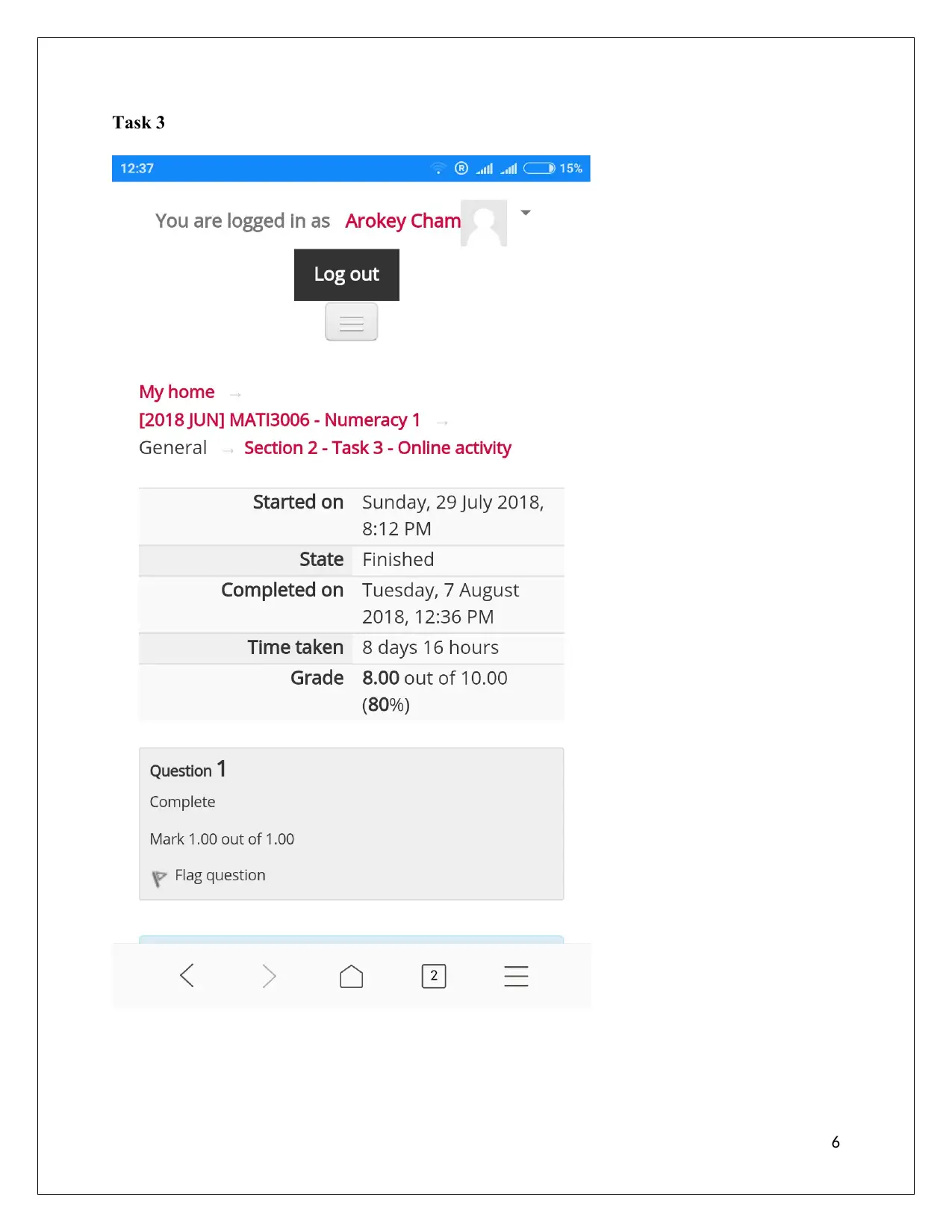
Task 3
6
6
⊘ This is a preview!⊘
Do you want full access?
Subscribe today to unlock all pages.

Trusted by 1+ million students worldwide
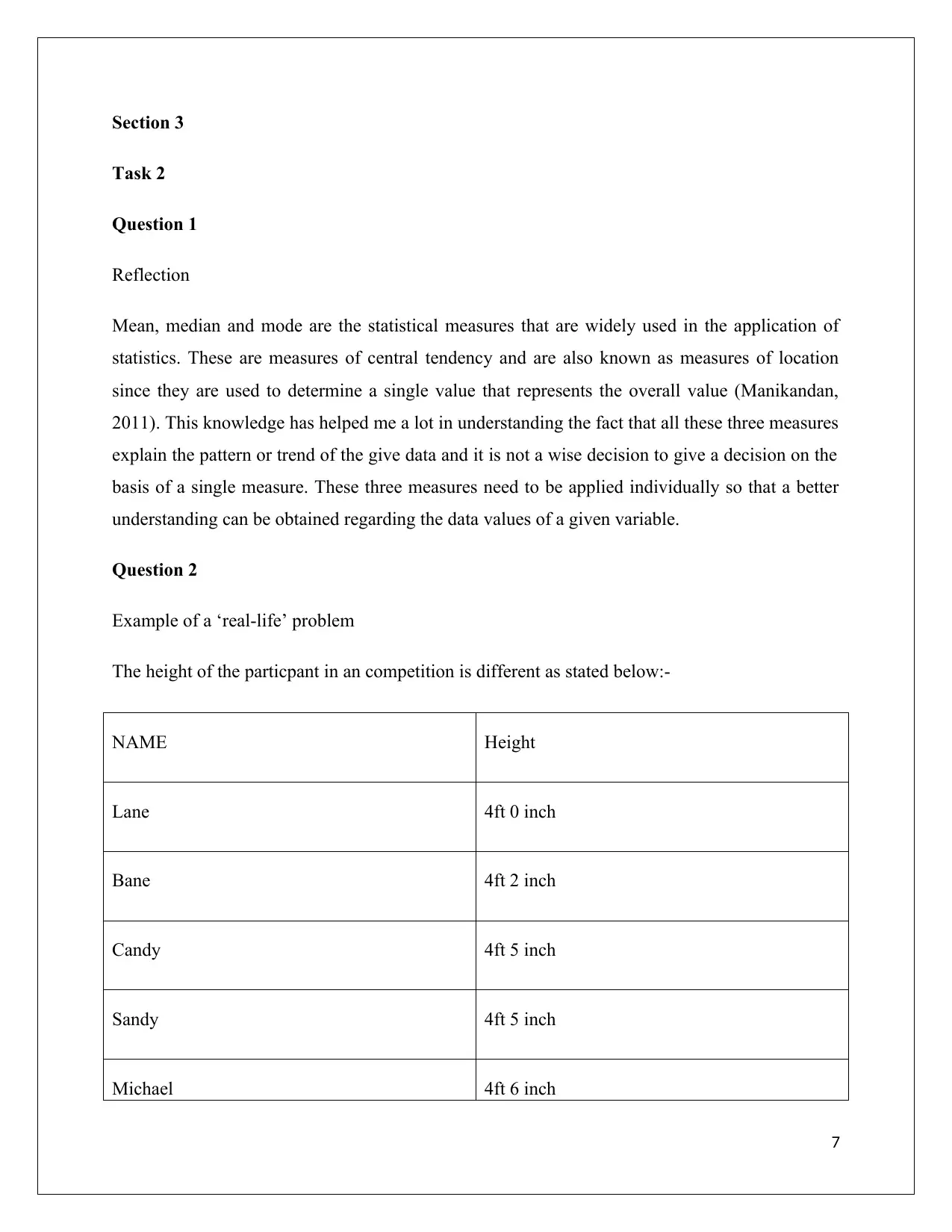
Section 3
Task 2
Question 1
Reflection
Mean, median and mode are the statistical measures that are widely used in the application of
statistics. These are measures of central tendency and are also known as measures of location
since they are used to determine a single value that represents the overall value (Manikandan,
2011). This knowledge has helped me a lot in understanding the fact that all these three measures
explain the pattern or trend of the give data and it is not a wise decision to give a decision on the
basis of a single measure. These three measures need to be applied individually so that a better
understanding can be obtained regarding the data values of a given variable.
Question 2
Example of a ‘real-life’ problem
The height of the particpant in an competition is different as stated below:-
NAME Height
Lane 4ft 0 inch
Bane 4ft 2 inch
Candy 4ft 5 inch
Sandy 4ft 5 inch
Michael 4ft 6 inch
7
Task 2
Question 1
Reflection
Mean, median and mode are the statistical measures that are widely used in the application of
statistics. These are measures of central tendency and are also known as measures of location
since they are used to determine a single value that represents the overall value (Manikandan,
2011). This knowledge has helped me a lot in understanding the fact that all these three measures
explain the pattern or trend of the give data and it is not a wise decision to give a decision on the
basis of a single measure. These three measures need to be applied individually so that a better
understanding can be obtained regarding the data values of a given variable.
Question 2
Example of a ‘real-life’ problem
The height of the particpant in an competition is different as stated below:-
NAME Height
Lane 4ft 0 inch
Bane 4ft 2 inch
Candy 4ft 5 inch
Sandy 4ft 5 inch
Michael 4ft 6 inch
7
Paraphrase This Document
Need a fresh take? Get an instant paraphrase of this document with our AI Paraphraser
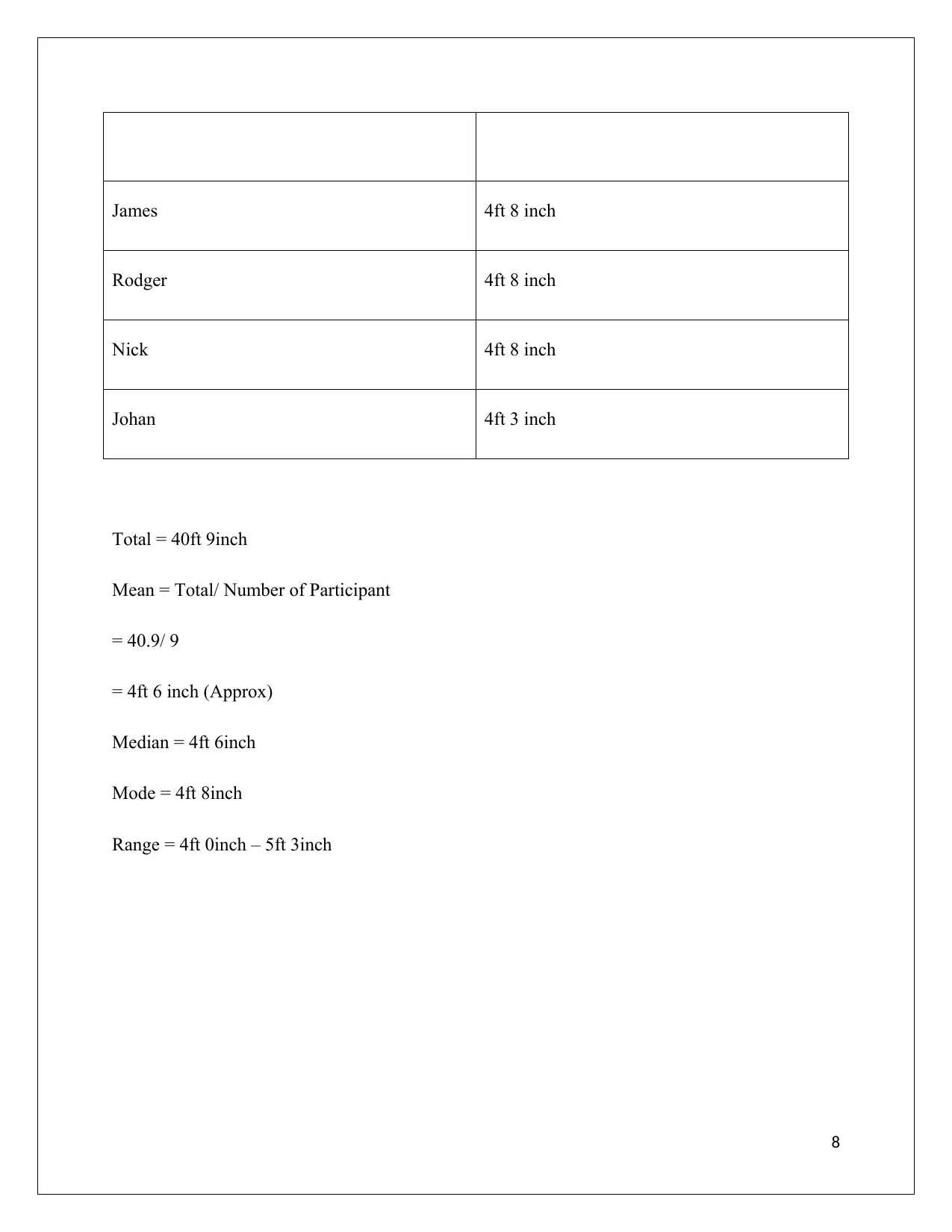
James 4ft 8 inch
Rodger 4ft 8 inch
Nick 4ft 8 inch
Johan 4ft 3 inch
Total = 40ft 9inch
Mean = Total/ Number of Participant
= 40.9/ 9
= 4ft 6 inch (Approx)
Median = 4ft 6inch
Mode = 4ft 8inch
Range = 4ft 0inch – 5ft 3inch
8
Rodger 4ft 8 inch
Nick 4ft 8 inch
Johan 4ft 3 inch
Total = 40ft 9inch
Mean = Total/ Number of Participant
= 40.9/ 9
= 4ft 6 inch (Approx)
Median = 4ft 6inch
Mode = 4ft 8inch
Range = 4ft 0inch – 5ft 3inch
8
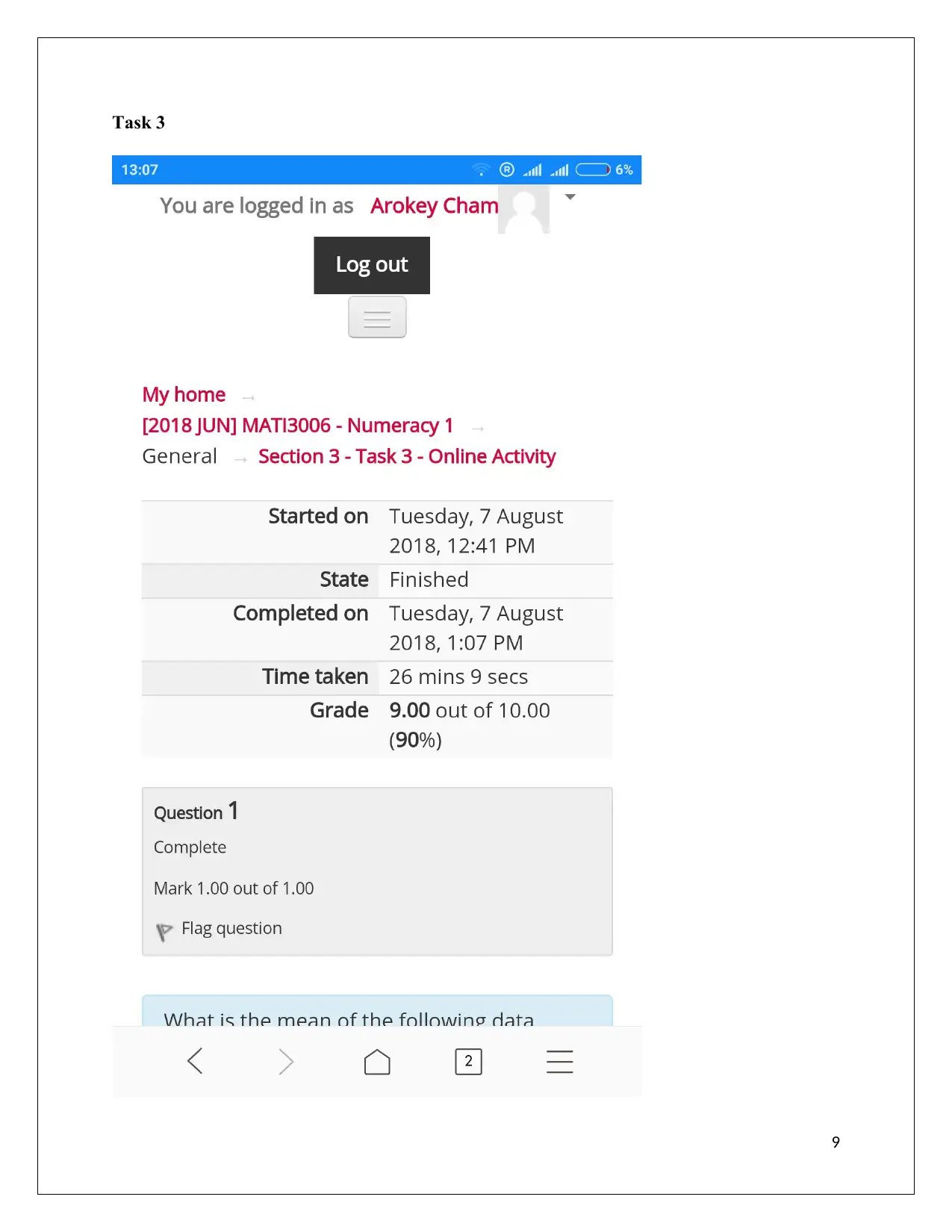
Task 3
9
9
⊘ This is a preview!⊘
Do you want full access?
Subscribe today to unlock all pages.

Trusted by 1+ million students worldwide
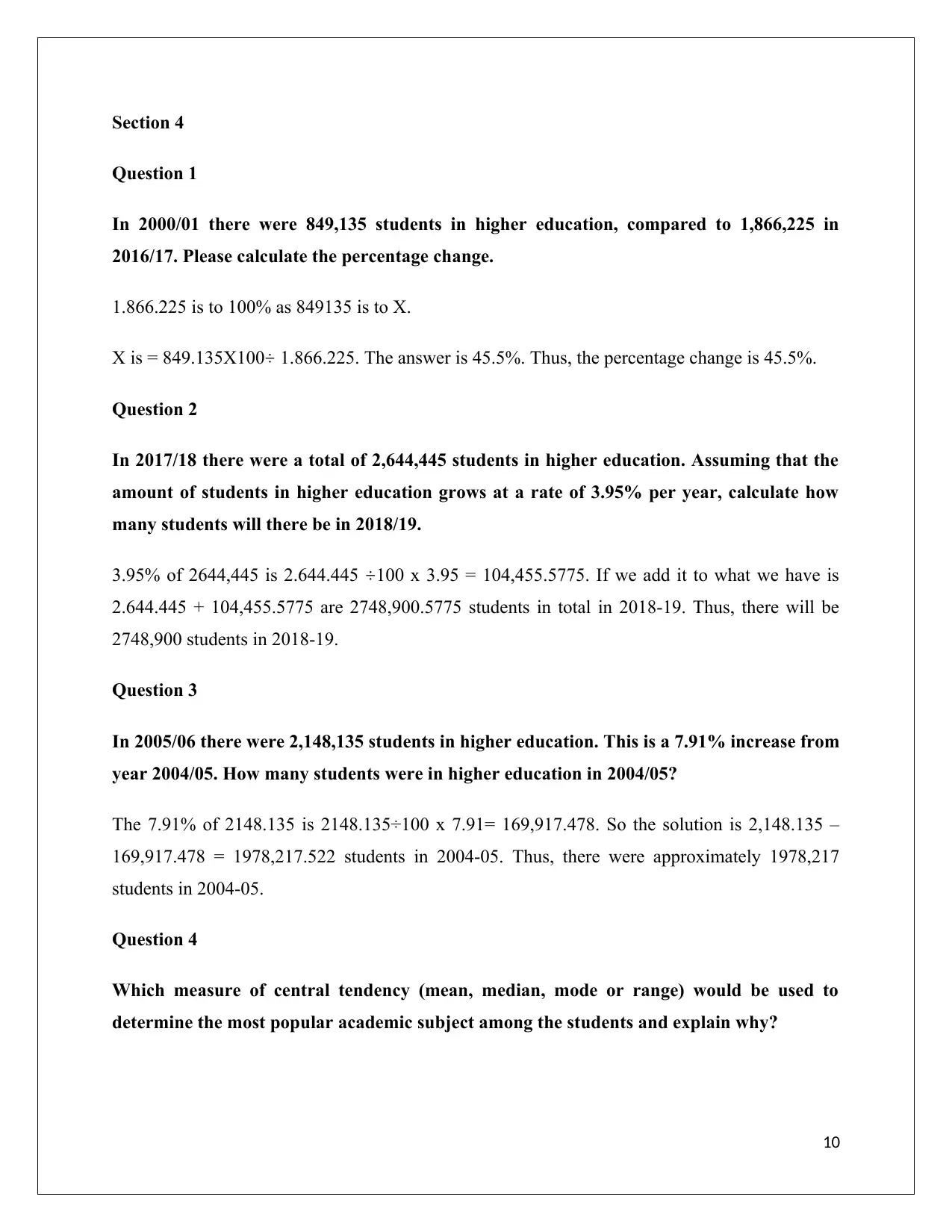
Section 4
Question 1
In 2000/01 there were 849,135 students in higher education, compared to 1,866,225 in
2016/17. Please calculate the percentage change.
1.866.225 is to 100% as 849135 is to X.
X is = 849.135X100÷ 1.866.225. The answer is 45.5%. Thus, the percentage change is 45.5%.
Question 2
In 2017/18 there were a total of 2,644,445 students in higher education. Assuming that the
amount of students in higher education grows at a rate of 3.95% per year, calculate how
many students will there be in 2018/19.
3.95% of 2644,445 is 2.644.445 ÷100 x 3.95 = 104,455.5775. If we add it to what we have is
2.644.445 + 104,455.5775 are 2748,900.5775 students in total in 2018-19. Thus, there will be
2748,900 students in 2018-19.
Question 3
In 2005/06 there were 2,148,135 students in higher education. This is a 7.91% increase from
year 2004/05. How many students were in higher education in 2004/05?
The 7.91% of 2148.135 is 2148.135÷100 x 7.91= 169,917.478. So the solution is 2,148.135 –
169,917.478 = 1978,217.522 students in 2004-05. Thus, there were approximately 1978,217
students in 2004-05.
Question 4
Which measure of central tendency (mean, median, mode or range) would be used to
determine the most popular academic subject among the students and explain why?
10
Question 1
In 2000/01 there were 849,135 students in higher education, compared to 1,866,225 in
2016/17. Please calculate the percentage change.
1.866.225 is to 100% as 849135 is to X.
X is = 849.135X100÷ 1.866.225. The answer is 45.5%. Thus, the percentage change is 45.5%.
Question 2
In 2017/18 there were a total of 2,644,445 students in higher education. Assuming that the
amount of students in higher education grows at a rate of 3.95% per year, calculate how
many students will there be in 2018/19.
3.95% of 2644,445 is 2.644.445 ÷100 x 3.95 = 104,455.5775. If we add it to what we have is
2.644.445 + 104,455.5775 are 2748,900.5775 students in total in 2018-19. Thus, there will be
2748,900 students in 2018-19.
Question 3
In 2005/06 there were 2,148,135 students in higher education. This is a 7.91% increase from
year 2004/05. How many students were in higher education in 2004/05?
The 7.91% of 2148.135 is 2148.135÷100 x 7.91= 169,917.478. So the solution is 2,148.135 –
169,917.478 = 1978,217.522 students in 2004-05. Thus, there were approximately 1978,217
students in 2004-05.
Question 4
Which measure of central tendency (mean, median, mode or range) would be used to
determine the most popular academic subject among the students and explain why?
10
Paraphrase This Document
Need a fresh take? Get an instant paraphrase of this document with our AI Paraphraser
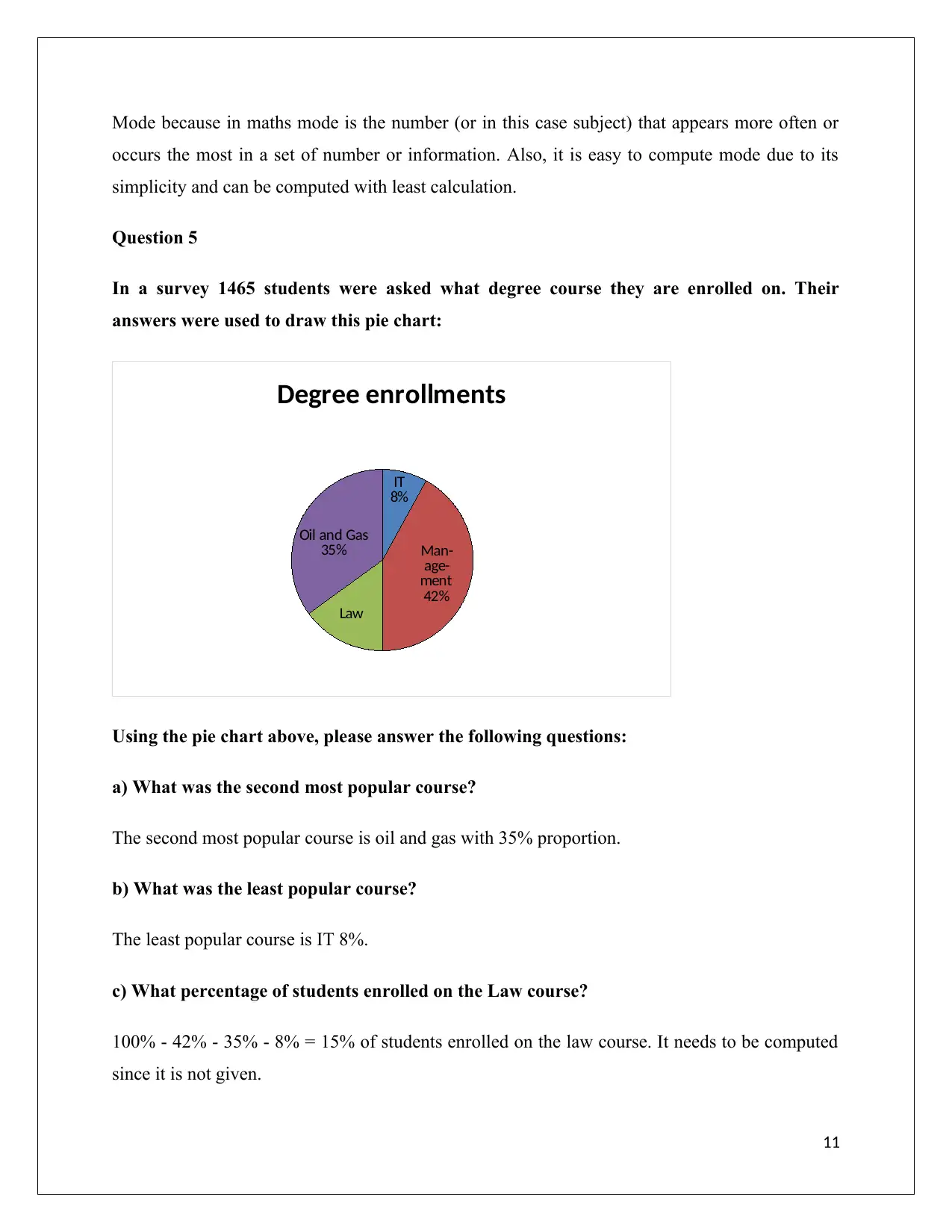
Mode because in maths mode is the number (or in this case subject) that appears more often or
occurs the most in a set of number or information. Also, it is easy to compute mode due to its
simplicity and can be computed with least calculation.
Question 5
In a survey 1465 students were asked what degree course they are enrolled on. Their
answers were used to draw this pie chart:
IT
8%
Man-
age-
ment
42%
Law
Oil and Gas
35%
Degree enrollments
Using the pie chart above, please answer the following questions:
a) What was the second most popular course?
The second most popular course is oil and gas with 35% proportion.
b) What was the least popular course?
The least popular course is IT 8%.
c) What percentage of students enrolled on the Law course?
100% - 42% - 35% - 8% = 15% of students enrolled on the law course. It needs to be computed
since it is not given.
11
occurs the most in a set of number or information. Also, it is easy to compute mode due to its
simplicity and can be computed with least calculation.
Question 5
In a survey 1465 students were asked what degree course they are enrolled on. Their
answers were used to draw this pie chart:
IT
8%
Man-
age-
ment
42%
Law
Oil and Gas
35%
Degree enrollments
Using the pie chart above, please answer the following questions:
a) What was the second most popular course?
The second most popular course is oil and gas with 35% proportion.
b) What was the least popular course?
The least popular course is IT 8%.
c) What percentage of students enrolled on the Law course?
100% - 42% - 35% - 8% = 15% of students enrolled on the law course. It needs to be computed
since it is not given.
11
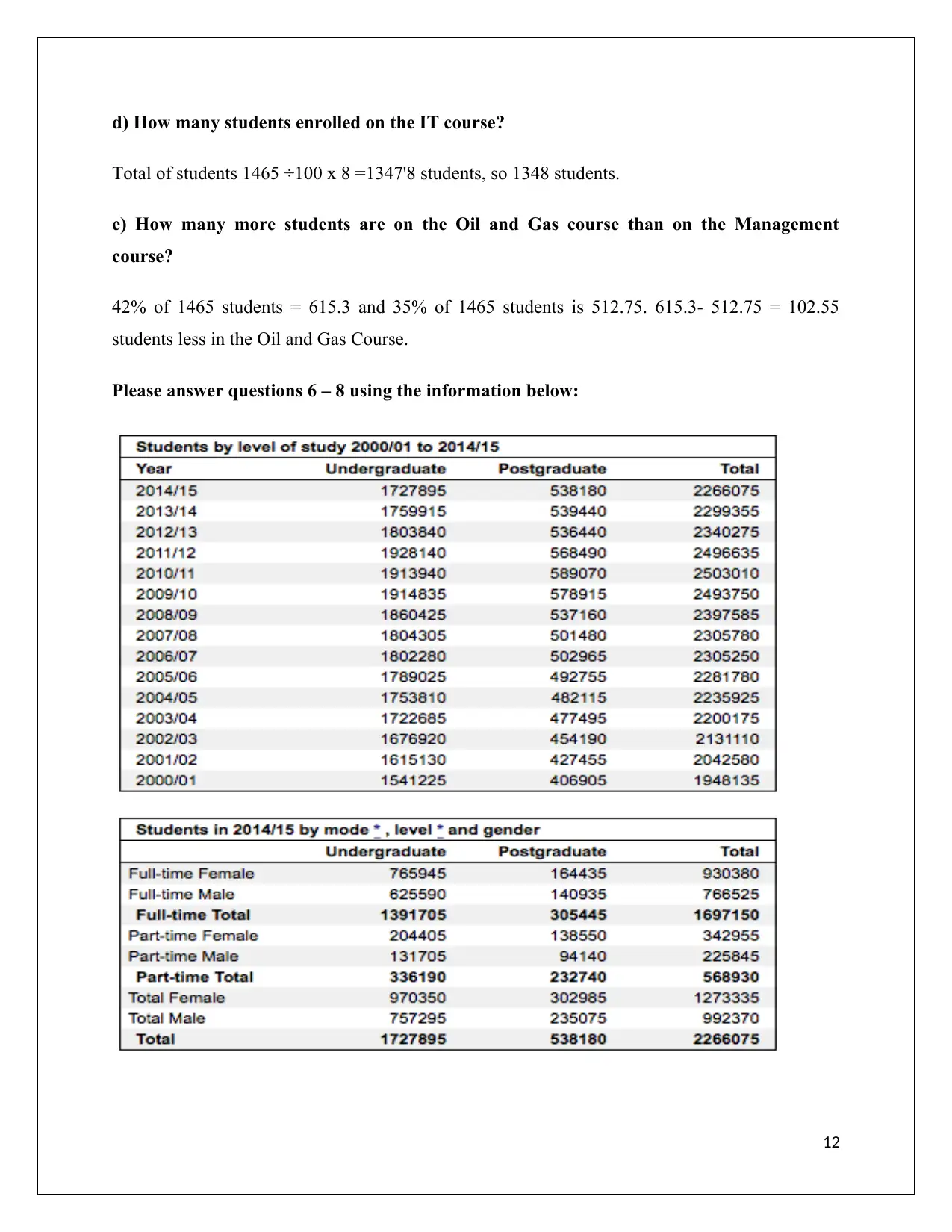
d) How many students enrolled on the IT course?
Total of students 1465 ÷100 x 8 =1347'8 students, so 1348 students.
e) How many more students are on the Oil and Gas course than on the Management
course?
42% of 1465 students = 615.3 and 35% of 1465 students is 512.75. 615.3- 512.75 = 102.55
students less in the Oil and Gas Course.
Please answer questions 6 – 8 using the information below:
12
Total of students 1465 ÷100 x 8 =1347'8 students, so 1348 students.
e) How many more students are on the Oil and Gas course than on the Management
course?
42% of 1465 students = 615.3 and 35% of 1465 students is 512.75. 615.3- 512.75 = 102.55
students less in the Oil and Gas Course.
Please answer questions 6 – 8 using the information below:
12
⊘ This is a preview!⊘
Do you want full access?
Subscribe today to unlock all pages.

Trusted by 1+ million students worldwide
1 out of 17
Your All-in-One AI-Powered Toolkit for Academic Success.
+13062052269
info@desklib.com
Available 24*7 on WhatsApp / Email
![[object Object]](/_next/static/media/star-bottom.7253800d.svg)
Unlock your academic potential
Copyright © 2020–2025 A2Z Services. All Rights Reserved. Developed and managed by ZUCOL.


